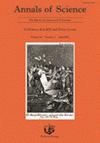亥姆霍兹与能量守恒:创造与接受的语境
IF 0.9
3区 哲学
Q2 HISTORY & PHILOSOPHY OF SCIENCE
引用次数: 0
摘要
同样能说明问题的是,没有提及波义耳创立的波义耳讲座,该讲座本应被用来说明科学和宗教的有效综合,其代表是在整个18世纪蓬勃发展的物理神学传统。与此同时,这本书的构思也有点狭隘。托马斯·霍布斯在书中没有出现,但至少对霍布斯的一些提及会有助于引起人们对新科学的无神论推论的广泛焦虑的根源的关注,在瓦德尔的论述中,这一点有点难以理解。当新科学传播到沙龙和咖啡馆时,我们本可以听到更多关于它的时尚半影(在书的简介中提到,但在书中根本没有提到),以及“智慧”而不是科学家在多大程度上放弃了魔法,这在这里被视为启蒙运动的特征。最后,这本书的时间安排有点不幸,因为作者没有机会阅读威廉·R·纽曼的权威研究《炼金术士牛顿》(2019),该研究一劳永逸地否定了牛顿的炼金术是他引力思想来源的观点。在这里,这一主张在B.J.T.多布斯和R.S.韦斯特福尔的著作的基础上得到了详细的重述,形成了关于炼金术的章节的高潮,不幸的是,这一章节已经过时了。因此,瓦德尔的卷显示出各种各样的缺点。然而,尽管如此,在这个关键时期,它应该有一定的价值,为学生们提供一个有用的介绍,让他们了解魔法、科学和宗教之间的复杂相互关系。本文章由计算机程序翻译,如有差异,请以英文原文为准。
Helmholtz and the conservation of energy: contexts of creation and reception
Equally telling is the omission of any reference to the Boyle Lectures that Boyle founded, which should surely have been taken up to illustrate the effective synthesis of science and religion represented by the tradition of physico-theology that flourished throughout the eighteenth century. Along with this goes a slight narrowness in the book’s conception. Thomas Hobbes nowhere appears in it, yet at least some reference to Hobbes would have been useful in drawing attention to the source of the widespread anxiety that existed about the supposedly atheistic corollaries of the new science, which in Waddell’s exposition is slightly hard to understand. We could also have heard more about the fashionable penumbra of the new science as it spread to the salons and coffee houses (referred to in the book’s blurb but not mentioned at all in its text), and the extent to which ‘wits’ rather than scientists made the running in the abandonment of magic which is here seen as characteristic of the Enlightenment. Lastly, the book is slightly unfortunate in its timing, in that its author did not have the opportunity to read William R. Newman’s magisterial study, Newton the Alchemist (2019), which once and for all scotches the view that Newton’s alchemy formed the source of his ideas about gravitation. Here, this claim is reprised at length on the basis of the writings of B.J.T. Dobbs and R.S. Westfall, forming the climax to the chapter on alchemy which is thus unfortunately already dated. Hence Waddell’s volume displays various shortcomings. In spite of these, however, it should have some value in providing students with a serviceable introduction to the complex interrelationship between magic, science and religion in this pivotal period.
求助全文
通过发布文献求助,成功后即可免费获取论文全文。
去求助
来源期刊

Annals of Science
综合性期刊-科学史与科学哲学
CiteScore
0.80
自引率
0.00%
发文量
22
审稿时长
1 months
期刊介绍:
Annals of Science , launched in 1936, publishes work on the history of science, technology and medicine, covering developments from classical antiquity to the late 20th century. The Journal has a global reach, both in terms of the work that it publishes, and also in terms of its readership. The editors particularly welcome submissions from authors in Asia, Africa and South America.
Each issue contains research articles, and a comprehensive book reviews section, including essay reviews on a group of books on a broader level. Articles are published in both English and French, and the Journal welcomes proposals for special issues on relevant topics.
The Editors and Publisher are committed to supporting early career researchers, and award an annual prize to the best submission from current doctoral students, or those awarded a doctorate in the past four years.
 求助内容:
求助内容: 应助结果提醒方式:
应助结果提醒方式:


